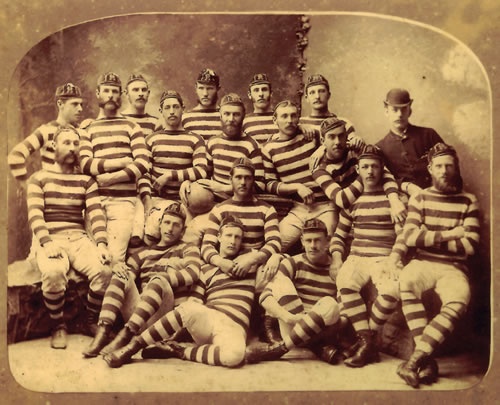
The 1883 Auckland representative team.
Back row: R. Whiteside, J. Sims, J. Mearns, T.B. O’Connor, F. Moginie, C.H. Croxton, A.H. Cotter (Umpire).
Middle row: G. Carter, J.C. Webster, T. Henderson (Capt.). W. Ring, T. Ryan, P. Spencer, R.O. Biggs.
Seated: J.H. Clayton, J. Arneil, J.H. Warbrick, J. Lecky.
One of the stars of this Auckland side was Joe Warbrick. Originally from the small Bay of Plenty settlement of Matatā, Warbrick came to the attention of the Auckland selectors in 1877 when as a 15-year-old playing for Ponsonby he regularly potted dropped goals from halfway – in bare feet. He remains New Zealand’s youngest first-class rugby player.
Warbrick was selected for the first New Zealand representative team in 1884 and made his debut against Cumberland County at Parramatta, New South Wales, in May. He is officially acknowledged as the 17th All Black (although this name was not applied to New Zealand representatives until 1905).
In 1888–89 Warbrick was the captain and undisputed leader of the New Zealand Natives team which toured Britain. This was the first New Zealand representative rugby team to tour beyond Australia.
Warbrick later became a tour guide in the geyser fields of Rotorua. Geyser tourism had been given a major boost in 1900 when the Waimangu (‘black water’) geyser burst into life. It was the largest known geyser in the world between 1900 and 1904. In August 1903 it exploded unexpectedly, killing Warbrick and three tourists.
Although he only played a handful of games for New Zealand, Joe Warbrick’s wider contribution to rugby was recognised in 2008 when he was inducted into the International Rugby Board’s Hall of Fame.

Community contributions